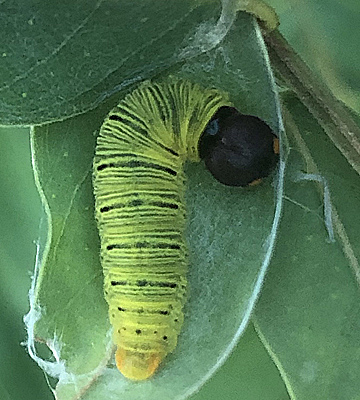Volume 27 Issue 3, Summer 2022
by BJ Lecrone, Audubon at Home Ambassador
The beautiful butterflies and moths have returned and very much need our help to create and protect their habitats. Two actions, mowing reduction and host plant installation, will make all the difference.

Snowberry Clearwing Moth (top) lays its eggs only on the native Coral Honeysuckle vine (bottom).
Photos by BJ Lecrone
Mow less! First and foremost is reckoning with our obsession with mowing. The dream of a perfect, short, green lawn that is free of “weeds” comes true with a plethora of mowing and weed-control products that help us achieve that coveted look. But this dream creates a nightmare, turning a habitat into a food desert.
We need to mow less to preserve more food sources for pollinators. I am fortunate to live in a non-HOA area where transitioning sections of lawn into no-mow zones naturally increases a supportive habitat for wildlife. This worthwhile undertaking gives big results but also requires management of invasive non-natives. Many of us have HOAs to enforce lawn standards, so one goal can be enlarging existing landscaping borders, removing non-native landscape plants as time allows, and replacing them with more natives.
My current plan is to decrease the need to mow circles around tree after tree and shrub after shrub by creating safe zones, with mow-free areas enveloping stands of trees and shrubs rather than individual circles around trees and shrubs. I mix in native flowering plants for each season to provide food and shelter, creating a safe haven for insects and birds. Try it! In short order, you’ll start noticing birds hopping among the plants searching for seeds and insects and butterflies and bees flying about.
Be a good host! Host plants support an abundance of pollinators. Don’t be fooled by the multitude of plants sold at a nursery or big box store. Many of those plants are non-natives originally from other parts of the world. Shop at native plant nurseries that have an abundance of pesticide-free, interesting, and unique native choices. Native plants in our region co-evolved with native insects to be host plants for hungry caterpillars. Our native caterpillars have developed special relationships with particular plants that are viable food sources for butterflies or moths.
Once you identify some host plants, search for chewed leaves. A leaf that is munched on likely indicates a caterpillar is enjoying it for food or shelter. One example of the host relationship is our beloved Monarch butterflies. They lay their eggs on milkweed, and the caterpillars eat only milkweed before turning into a chrysalis. About two weeks later a new Monarch emerges.

A bee enjoys the flowers of a False Indigo Bush.
Photo by BJ Lecrone
Be the agent of change! This is key to helping butterflies and moths. After five years of research and education, I have developed a passion for creating a sustainable habitat at our homes. I hope you will join me on this journey to learn and experience the native transition in our yards and communities. You will naturally demand more wildlife protections from your landscaper, mowing service, HOA board, neighbors, and plants stores. I hope you’ll follow my example and use your voice for change on behalf of all living things.
I encourage you to learn about the plants that support caterpillars and to establish more mow-free zones that include native plants. You’ll support wildlife and save gas by NOT mowing as much of your lawn. Embrace the freedom; join me on the wild side.
Resources:
Our Planting for Wildlife publication and web tool: https://www.novawildlifegarden.net/
Audubon at Home Ambassadors certification
Events and plant information from our partner Plant NOVA Natives

Silver-spotted Skipper butterfly caterpillar on host plant.
Photo by BJ Lecone
Host Plants for Pollinators
Many butterflies and moths have more than one host plant. Here are just a few natives to consider planting if you want to host more pollinators’ caterpillars:
- Coral Honeysuckle (Lonicera sempervirens) vine is a host plant for many moths and butterflies, including the Snowberry Clearwing Moth and Spring Azure butterfly.
- False Indigo Bush (Amorpha fruticosa) is a host plant to butterflies (including the Silver-spotted Skipper and Gray Hairstreak) and moth species.
- Black Cherry (Prunus serotina) tree is a host plant for the Red-spotted Purple and many other butterflies.
- Wild Indigo (Baptisia spp.) plants may host caterpillars of a number of butterflies, including the Wild Indigo Duskywing and Clouded Sulphur.
Vegetable gardeners, please note: Hornworms, which quickly feast on nightshade family plants, including tomatoes, are actually the caterpillar of the Five-spotted Hawk moth! Please forgive these soon-to-be beautiful pollinators and plant a few additional plants to share with them.

